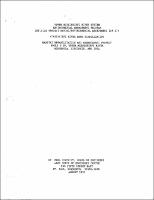Please use this identifier to cite or link to this item:
https://hdl.handle.net/11681/36773Full metadata record
| DC Field | Value | Language |
|---|---|---|
| dc.contributor.author | United States. Army. Corps of Engineers. St. Paul District | - |
| dc.date.accessioned | 2020-05-27T14:06:48Z | - |
| dc.date.available | 2020-05-27T14:06:48Z | - |
| dc.date.issued | 1995-08 | - |
| dc.identifier.uri | https://hdl.handle.net/11681/36773 | - |
| dc.description | Definite Project Report with Integrated Environmental Assessment | - |
| dc.description.abstract | The bank stabilization sites investigated are located along the Mississippi River or its side channels from near Alma, Wisconsin, in pool 5 to Guttenberg, Iowa, in pool 10. The sites are located on both sides of the navigation channel and are all in the Upper Mississippi River National Wildlife and Fish Refuge. About 90 percent of the 200,000-acre study area is aquatic/wetland in nature. Erosion of existing islands and side channels allows increased wave action and/or flow into backwater areas. The associated sediment and turbidity are contributing to the degradation in quality of the wildlife and fish habitat in the backwaters. The ultimate goal is to preserve, restore, and enhance backwater fish and migratory bird habitat on the Upper Mississippi River Wildlife and Fish Refuge. Specific project objectives include: maintaining existing island shoreline; reducing flow in side channels or between islands; and eliminating normal flow through breaches in existing islands. Fifty-five critical erosion sites were initially submitted by the U.S. Fish and Wildlife Service and the Wisconsin, Minnesota, and Iowa Departments of Natural Resources for consideration. The plan formulation process considered several physical alternatives to control flow and prevent erosion of islands or riverbanks. These included shoreline protection, partial closures, offshore rock mounds, constriction of side channel openings, and reshaping of the riverbanks. Stabilization of each erosion site was evaluated to determine cost, the degree of habitat improvement, and constructability. Based on the cost for habitat benefits gained, agency priorities, location, construction considerations, and available funds, a total of 12 sites were selected for stabilization. The selected plan addresses the project objectives by reducing erosion of side channels; limiting or reducing flows into side channels; and preventing erosion of existing barrier islands near the navigation channel. The plan of action includes constructing rockfill bank stabilization or closures in pools 6 through 10 (2 sites in pool 6, 1 site in pool 7, 1 site in pool 8, 3 sites in pool 9, and 5 sites in pool 10). The type of stabilization depends on physical conditions at the site, but would basically use rockfill in the form of wedges along the riverbank, offshore mounds, riprap on the riverbank, and groins. About 28,000 cubic yards of rockfill would be used to stabilize 12,000 feet of shoreline. It is estimated that up to 18,000 cubic yards of material may need to be dredged to gain construction access at the sites. This material would be used in the bank stabilization structure, placed behind the structure, or transported to an upland site. The total estimated direct construction cost of the project is $1,949,000. Indirect costs for planning, engineering, and design efforts and construction supervision and administration bring the total project cost to $2,539,000. Average annual operation and maintenance costs of the project are estimated to be $4,920 and would be the responsibility of the U.S. Fish and Wildlife Service. The selected plan would directly affect 1,500 acres of backwater habitat. The backwater habitat would be improved as a result of less sediment input into the backwater. Stabilization of existing islands and riverbanks would prevent increased wave action so that the quality of the backwater habitat would be maintained or preserved. Fish habitat would be improved by increasing habitat diversity arid dredging for construction access would provide about 3 acres of additional deepwater habitat for species such as bluegill, crappies, and largemouth bass. The increased stability of the aquatic plant beds would lead to increased use of the areas by waterfowl because of the food provided and increased habitat diversity. No archaeological or historical sites listed on the National Register are known to be affected by the proposed project. Three of the sites selected may be accomplished by the U.S. Fish and Wildlife Service using funds made available to repair flood damage on the Refuge caused by the 1993 flood. These sites were not eliminated from the selected plan because implementation has not been completed. If these sites are completed before the preparation of plans and specifications or if project costs are less than the current estimate, additional sites from the initial projects list would be selected to utilize funds allocated for the Bank Stabilization project. The selected sites would be coordinated with the partner agencies and the proper supplemental environmental documentation would be done. | en_US |
| dc.description.sponsorship | United States. Army. Corps of Engineers. | en_US |
| dc.format.extent | 479 pages / 44.63 MB | - |
| dc.format.medium | PDF/A | - |
| dc.language.iso | en_US | en_US |
| dc.publisher | United States. Army. Corps of Engineers. St. Paul District. | en_US |
| dc.rights | Approved for Public Release; Distribution is Unlimited | - |
| dc.source | This Digital Resource was created from scans of the Print Resource | - |
| dc.subject | Restoration ecology | en_US |
| dc.subject | Environmental protection | en_US |
| dc.subject | Environmental management | en_US |
| dc.subject | Wetlands | en_US |
| dc.subject | Mississippi River | en_US |
| dc.title | Upper Mississippi River System Environmental Management Program Definite Project Report/Environmental Assessment (SP-17) : Mississippi River Bank Stabilization Habitat Rehabilitation and Enhancement Project, Pool 5-10, Upper Mississippi River, Minnesota, Wisconsin, and Iowa | en_US |
| dc.type | Report | en_US |
| Appears in Collections: | Environmental Documents | |
Files in This Item:
| File | Description | Size | Format | |
|---|---|---|---|---|
| MissRvBankStab_DPR.pdf | 44.63 MB | Adobe PDF |  View/Open |